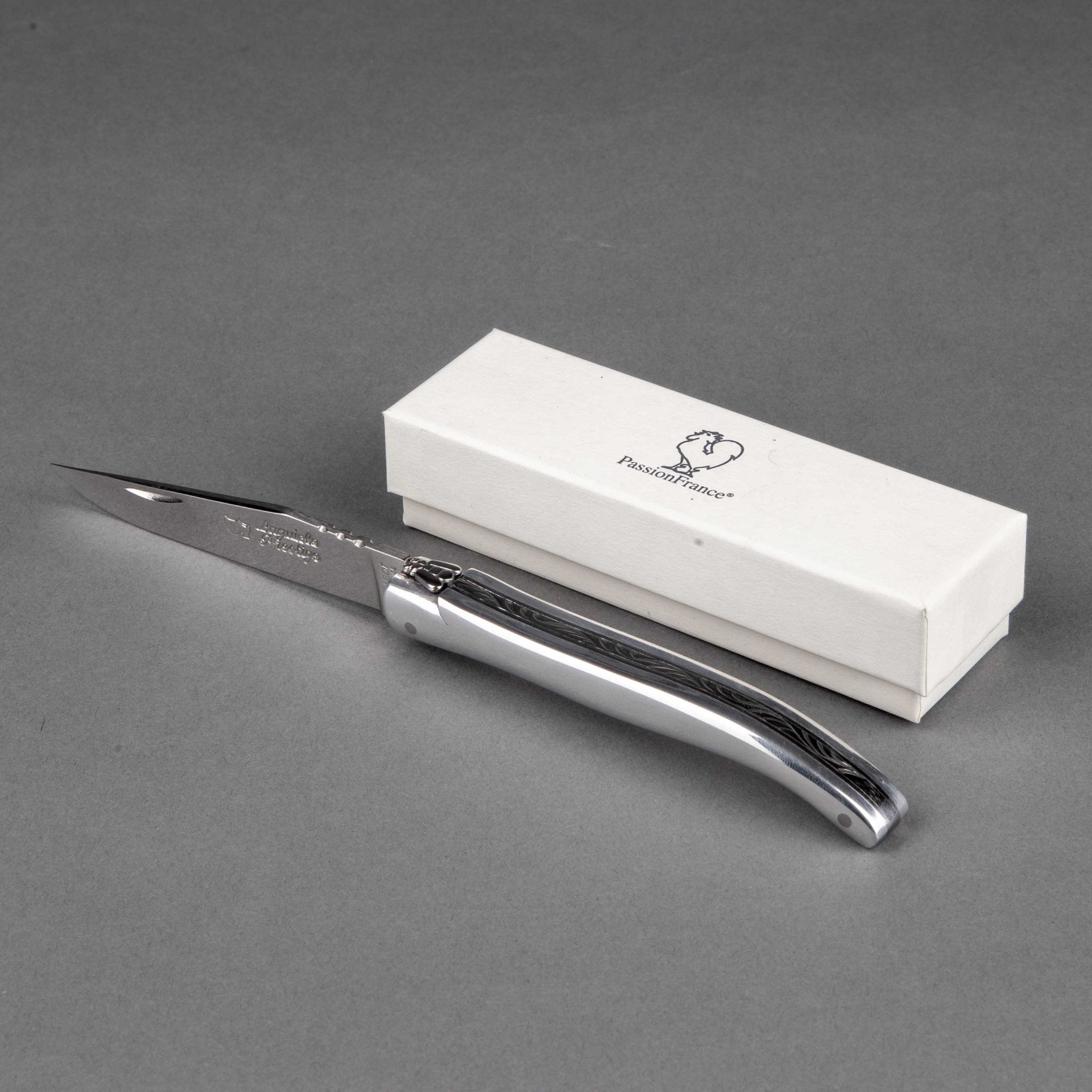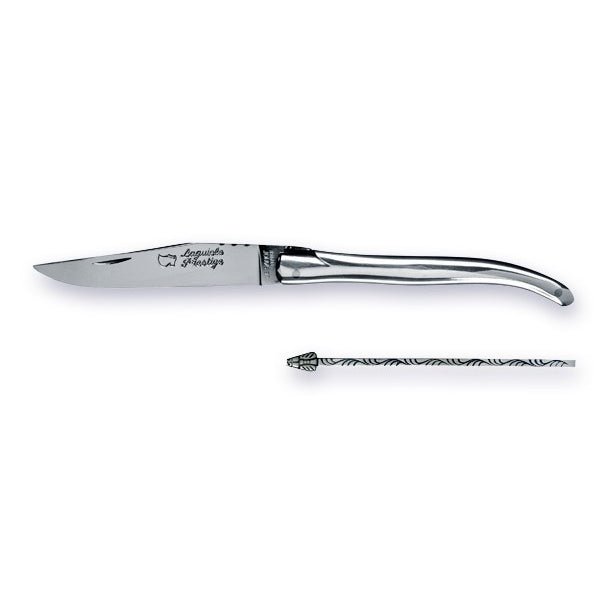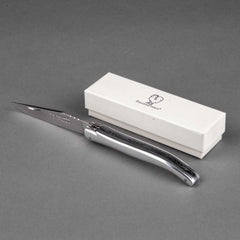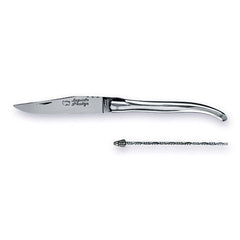- Choosing a selection results in a full page refresh.




Compared to knives from other regions of France, the lines of a Laguioleare slim and elegant... unusually delicate for a knife that was at home in a farming environment, which consisted essentially of farmers and stockbreeders or routiers, who traveled through the country as traveling traders with their ox or donkey carts and traded in the products of their homeland.
One would think that knives for such a target group would not be as elegant as Laguioles are. But the surprising thing is that its slender handle fits so well in the hand and follows the lines of the hand so perfectly that it couldn't be stronger.
It is also undisputed that to date, none of France's numerous knives have provoked such a debate among architects, designers and creative people. A possible answer to this question probably lies in this special feature, its unusually elegant lines.
The story of the Laguioles has been told to us for years in the fairy tales and legends that circulate among the rural population of Aubrac and how they brought the blacksmiths into circulation. Once Upon a time …
- In 1828, a young blacksmith named Pierre-Jean Calmels created a knife that soon became the most popular knife in France because of its slender lines, elegance and balanced proportions.
- the Laguiole is a cross between the Capuchadou dagger common in Aubrac and a knife native to Spain called Navaja, which the traveling traders discovered and brought back with them on their travels.
- some say that real pocket knives that fold up, i.e. with a compartment in the back, did not exist until then. The invention of the modern pocket knife was an invention of the blacksmiths in Laguiole.
- the Croix Berger, the decoration called a shepherd's cross made of small metal pins on the handle, was once used by the shepherds for a quick prayer when they watched the dangerous nights with the animals in the pasture. It must consist precisely of 7 little nails, otherwise it is not real, because it symbolizes the days of the week.
- the fly on the resort is not a fly, but Napoléon's heraldic animal, a bee. The Emperor only granted the blacksmiths in Laguiole the right to depict his heraldic animal on their knives, because they had fought particularly bravely in his battles...
All of this flatters the narrator, is charming, but has nothing to do with the historical truth, as we know today.
Nevertheless, we should enjoy stories like the ones that embellish the world of Laguioles, because no other knife is told so frequently about them. And France has over sixty different traditional pocket knives! Some younger, but some much older than the Laguiole.
In addition to the legends, we can also get to know the historically correct story with the exact dates as it has recently become known:
- the first blacksmith shop founded in the village of Laguiole in 1828 was the Moulin blacksmith shop; The blacksmith Jean-Pierre Calmels, who is said to have invented the knife in 1828, only settled here a year later, in 1829, at the same time as the blacksmith Glaize. In the years that followed, other blacksmiths settled in Laguiole.
- for many it was never quite understandable that a very young blacksmith like Pierre-Jean Calmels (according to the story in 1828) at the age of only 16 should have "invented" a knife with such perfect lines. So not a seasoned blacksmith with craftsmanship experience or an experienced craftsman with design know-how? The knife is said to have been created immediately in its finished, final form, developed from a Navaja, which is structurally different, and a fixed dagger, the Capuchadou? Without intermediate steps in development? This leaves experienced designers and knife makers in doubt.
- Napoleon's bee in the department. Napoléon was deposed in 1815 and with his deposition and banishment all of his insignia had to be destroyed (see the rediscovery of the subject Napoléon), and it was forbidden under punishment to continue using his insignia, including his heraldic animal, the bee . Napoléon died in 1825. The first blacksmiths settled in Laguiole in 1828 and the first original Laguioles were created around 1850 as we know today...
Christian Lemasson is a historian and ethnographer. He lives in Aubrac near Laguiole and in Thiers. Coming from a family of Couteliers, he asked the same questions, spent 9 years researching the history and evolution of Laguiole knives and his forge, and published his research in 2010 in the book L'HISTOIRE DU COUTEAU DE LAGUIOLE. As part of his research, he was able to view more than just the documents in public archives. He was given access to private archives, including archives of some defunct blacksmiths in Laguiole and Thiers, whose families had kept the original documents. The results of his work allowed him to reconstruct the history of Laguiole on a secure scientific basis.
For anyone who would like to read the story in its entirety: we provided expert and advisory support for the German translation for Wieland-Verlag by Thomas Mößer.
This knife was manufactured by the Au Sabot company, with the wooden shoe as its trademark. Au Sabot looks back on 150 years of history, making it one of the oldest company histories in France. A few years ago the company was awarded the honorary title Patrimoine Vivant, living cultural asset.
A specialty of the company are the Laguioles à l'ancien, i.e. made in the old traditional way, which, like the Laguiole Art Déco, have been made for generations using the old tools and with the old attributes.
Since 1994, Au Sabot has been a member of the "Confrérie du Couté de Tié".
In 2008, the cutlery was honored with the Entreprise du Patrimoine Vivant award, which is given to manufacturers with special, traditional knowledge.
Folded length: 12cm, blade: 9.5cm, welded bee, aluminum handle
The knife is delivered in a black box with a cleaning cloth and a detailed description.
Free priority shipping for orders over SFr. 100. Orders are usually shipped on the same or next business day (if ordered after 15:00). Excludes Monday (our day off).
We ship parcels abroad with UPS. The total price including shipping, customs and VAT will be shown to you in the last step of the checkout process before you complete the purchase. All costs are already paid here in the shop, nothing is due upon receipt (DDP - Delivered Duty Paid).
You can return most items for a full refund within 14 days of delivery. Items must be returned in new condition (i.e. unworn, unwashed, with all tags etc.). We will pay for the return postage if the return is due to an error on our part (you received an incorrect or defective item, etc.).
You can expect to receive your refund within one to two weeks of the package being delivered to the Post Office/UPS, but in many cases it will be quicker. This includes the time it takes for us to receive your return from the carrier (1 to 3 working days), the time it takes for us to process your return once we receive it (1 working day), and the time it takes for your bank, credit card company, Postfinance, Twint, etc. to process our refund request (immediately up to 10 working days).If you want to return an item, please indicate whether you want a refund or an exchange.
All items that can be ordered are usually available and can be shipped immediately. If there are any errors, you will be informed immediately.
Most, but not all, of the items displayed in the web shop are in stock in our physical stores. Motorcycle clothing may be held in our off-site warehouse in winter due to space constraints, just as heavy knitwear, coats or autumn/winter hats may be held in our off-site warehouse in summer.
Single items and sale items are also often held in the off-site warehouse.
Red Wing and other footwear is stocked year round.
It is best to enquire about a specific item before visiting.
Are you interested in a sold out item? We will be happy to let you know if and when we expect it back in stock.
Thanks for subscribing!
This email has been registered!
It is our aim to always serve you to your complete satisfaction. This also includes our fair terms and conditions.
By submitting an order you expressly agree to these terms and conditions.
Deliveries are limited to delivery addresses in Switzerland and Liechtenstein
We only supply brand new products in original brand quality.
Delivery conditions:
We deliver your order within 2 days of receipt of the order or payment via Swiss Post. Orders are usually sent together in one package and not in individual shipments.
Most items are in stock and available for immediate delivery. For items that are not in stock, the average delivery time is 4 weeks. You will be informed on the same or following working day if an item is not in stock. Please ask us about stock levels if the items are urgently needed.
Orders & Prices:
All orders are binding. If there is a delay in delivery, you will be informed by email or telephone. If the delivery has not yet been sent, you have the option of cancelling it.Price and product range changes as well as technical changes are reserved. All offers are subject to change. Errors and misprints excepted.Payment
In the webshop, orders are processed against
- Credit cards / Paypal
- Postcard
- Twint
- Purchase on account with partial payment option (POWERPAY)
As an external payment service provider, MF Group / POWERPAY offers the payment method “purchase on account”. With the individual invoice, you can easily pay for your online purchase by invoice. If you do not pay within the specified time frame, you will subsequently receive a monthly invoice with an order overview in the following month.
When the purchase contract is concluded, POWERPAY takes over the invoice claim and handles the corresponding payment terms. When purchasing on account, you accept POWERPAY 's general terms and conditions in addition to ours (powerpay.ch/de/agb).
Deliveries to the EU:
Shipping costs with UPS, customs clearance fees and VAT are included in the total price (visible in the last step of checkout). There are no additional costs upon receipt (DDP - Delivered Duty Paid).
Shipping costs Switzerland / Principality of Liechtenstein:
Orders with a purchase value of CHF 100 or more will be shipped free of charge.
For orders with a purchase value of less than CHF 100, we charge CHF 7 for Economy and CHF 9 for Priority shipping.
Dealers (B2B) on request.
Refund policy:
If you return the purchased goods within 14 days in perfect condition and in the original packaging, we will refund you the full purchase price. The costs for the return shipment are at your expense.
Data protection:
British Parts collects data and uses it to process orders and to make shopping as easy as possible for returning customers. Personal data is treated confidentially and is not passed on to third parties for advertising purposes.
We store open and completed orders. This data can be viewed at any time in the password-protected login area.
If you have any questions about our contractual terms and conditions, please contact us by email ( info@britishpartsluzern.ch ) or by phone (041 530 00 31).
Our business activities are based exclusively on Swiss law. The place of jurisdiction is Rothenburg.